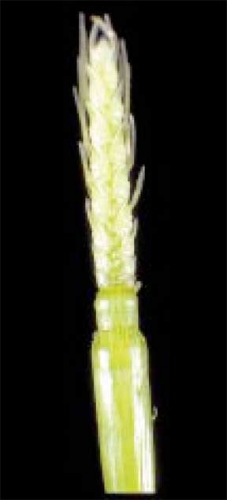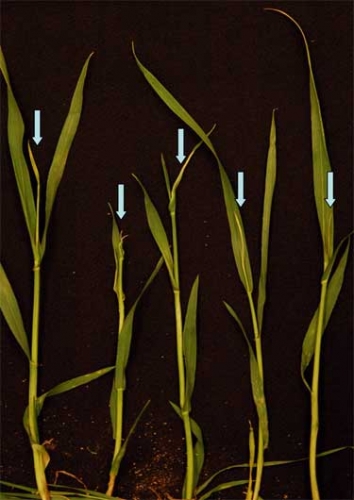Recent freeze threatens wheat crop
Injury from Sunday, April 28’s cold temperatures may represent a significant threat to some of Michigan’s wheat crop.
During the overnight and early morning of Saturday, April 28, and Sunday, April 29, temperatures plummeted well below freezing. Earlier this spring, sub-freezing temperatures injured the crop to some extent, but for this most recent event, the crop is only a couple weeks from heading and, therefore, was much more vulnerable. At this writing (May 3), the damage appears to be less severe than research suggests. Nevertheless, it often requires at least a week for symptoms to become evident, so fields within areas of the state that experienced the coldest temperatures should be observed closely. The level of injury depends on the actual temperature, the length of time the cold temperature persists, and the stage of wheat development.
Minimum temperatures across Michigan on April 29 are displayed in Figure 1. Subfreezing temperatures occurred over all, but extreme southwestern sections of the state where clouds and a slight breeze moderated surface cooling rates. Coldest readings (in some cases less than 20°F) occurred over interior sections of the Thumb region and northern lower and western upper Michigan.
Figure 1. Observed minimum temperatures (at
the 5-foot level) April 29, 2012. The contoured surface was derived from more
than 150 individual observations. Coldest temperatures are depicted by the
darkest colors. Data courtesy of the Michigan
State Climatology Program and MSU
Enviro-weather.
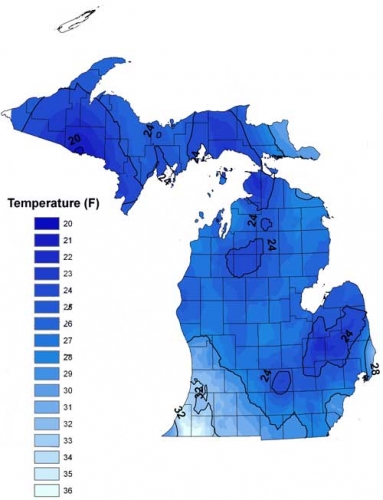
The cold weather was associated with a large, Canadian-origin air mass centered over southern Ontario, Canada. As a result, the freeze was a radiation-type event, with relatively clear skies, calm winds, and inversion conditions where temperatures just above the surface increase with height. During radiation-type freeze events, coldest air temperatures are typically found in a shallow layer just above the ground surface or at the top of the crop canopy. The relatively colder, denser air that forms near the surface may then slowly flow across the landscape, collecting in depressions and other low-lying areas. Worst damage associated with the event would therefore be expected in low-lying pockets, valleys, or other low areas of fields where the air temperatures were coldest.
As noted earlier, it is also important to consider the duration of sub-freezing temperatures. The number of hours the air temperature remained at or below 28°F and 24°F are plotted for the Lower Peninsula in Figures 2a and 2b, respectively. For illustration, wheat-producing areas are outlined (in black) in Figure 2a. Temperatures fell to or below 28°F for at least six hours across portions of the Thumb and in an area from Mecosta and Isabella counties northward, to Charlevoix and Emmet counties.
Figure
2a. Observed number of hours at or below 28°F, between 6 p.m. April 28 and 9
a.m. April 29. Winter wheat-producing areas (during the 2010 growing season)
are outlined in black based on data from the USDA-NASS Cropland
Layer dataset. All meteorological data were provided by the Michigan
State Climatology Program and MSU
Enviro-weather.
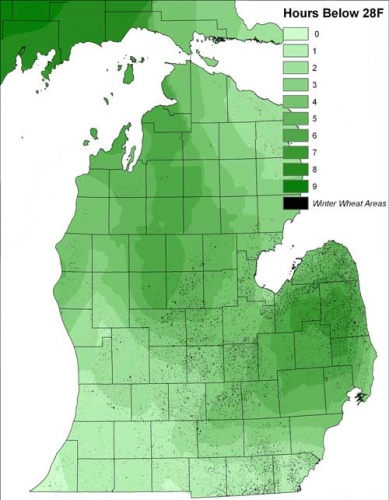
From Figure 2b, it can be seen that temperatures fell to 24°F lower for at least three hours across portions of Sanilac, Huron, Tuscola, Lapeer, and St. Clair counties, including some major wheat production areas of the state and region.
Figure
2b. Observed number of hours at or below 24°F, between 6 p.m. April 28 and 9
a.m. April 29. All meteorological data were provided by the Michigan
State Climatology Program and MSU
Enviro-weather.
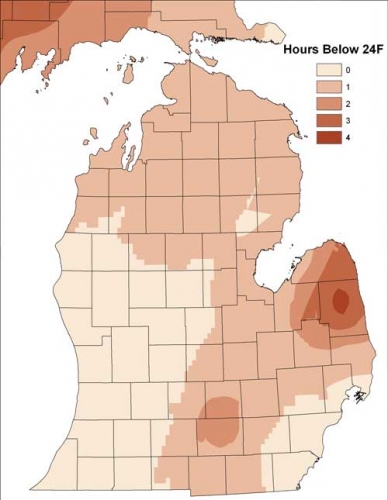
Currently, the majority of the crop is already in growth stages 7 or 8 (second joint or emergence of flag leaf tip, respectively), placing it approximately two weeks ahead of normal. At this stage, the wheat can be vulnerable to temperatures that persist for at least two hours at or below 24 degrees, according to work done in Kansas (see Spring Freeze Injury to Kansas Wheat by Kansas State University). This work described the critical temperatures for freeze injury at selected stages of wheat growth, and provides the associated injury symptoms and effect on yield (Table 1).
Table 1. Temperatures that cause freeze injury to wheat at spring growth stages and symptoms and yield effect of spring freeze injury | |||
|
Growth stage |
Approximate injurious temperature (two hours) |
Primary symptoms |
Yield effect |
|
Tillering |
12°F |
Leaf chlorosis;, burning of leaf tips; silage odor; blue cast to fields |
Slight to moderate |
|
Jointing |
24°F |
Death of growing point; leaf yellowing or burning; lesions, splitting, or bending of lower stem; odor |
Moderate to severe |
|
Boot |
28°F |
Floret sterility; spike trapped in boot; damage to lower stem; leaf discoloration; odor |
Moderate to severe |
|
Heading |
30°F |
Floret sterility; white awns or white spikes; damage to lower stem; leaf discoloration |
Severe |
|
Flowering |
30°F |
Floret sterility; white awns or white spikes; damage to lower stem; leaf discoloration |
Severe |
|
Milk |
28°F |
White awns or white spikes; damage to lower stems; leaf discoloration; shrunken, roughened, or discolored kernels |
Moderate to severe |
|
Dough |
28°F |
Shriveled, discolored kernels; poor germination |
Slight to moderate |
Source: J. Shroyer, M. Mikesell, & G. Paulsen, Spring Freeze Injury to Kansas Wheat, Kansas State University, March 1995. | |||
Symptoms of freeze injury include leaf burning. However, even in the absence of leaf burn, be it to the emerging flag leaf or the older leaves, the growing point of individual tillers may be killed. After several days following the freeze, stems should be cut longitudinally to observe the developing head. Healthy heads will have a whitish-green appearance, while damaged heads tend to have a bleached, soft appearance.
The primary tillers tend to be damaged most severely. Damaged tillers will stop elongating or, if they are able to sustain limited growth, their emerging head will often be white and shriveled. Plant resources will be diverted to undamaged tillers, allowing them to partially compensate for the loss of the damaged tiller.
|
|
As growers survey their crop, they may find that varieties differ in their level of sensitivity to cold temperatures. Some varieties also have a stronger tendency to tiller and these may demonstrate a greater ability to recover from the injury. Some wheat fields may continue to grow and develop, but may later exhibit stem damage and an increased tendency to lodge. In addition, field scouts should be wary of collapsing canopies as they may be more likely to harbor diseases and insect pests.
At this juncture, it is not clear the degree to which Michigan’s wheat crop may have been injured. Currently, Michigan lacks experience with extreme temperatures during the growing season and needs to rely on the research conducted elsewhere. It is possible that local varieties are more tolerant of cold temperatures than predicted or the crop may have been able to acclimate to some extent following the repeated freezing temperatures in recent weeks. In any case, growers and field personnel are encouraged to carefully assess their fields in the weeks to come to determine for themselves the extent of injury.
Sources:
- Shroyer,
Mikesell, and Paulsen, Spring Freeze Injury to
Kansas Wheat, Kansas State University. March 1995
- Erick DeWolf, Plant Pathologist, Kansas State University, personal correspondence, May 1, 2012
Related MSU Extension News articles:
- Freeze injury to wheat, Martin Nagelkirk
- Winter wheat’s winter survival, Martin Nagelkirk



 Print
Print Email
Email